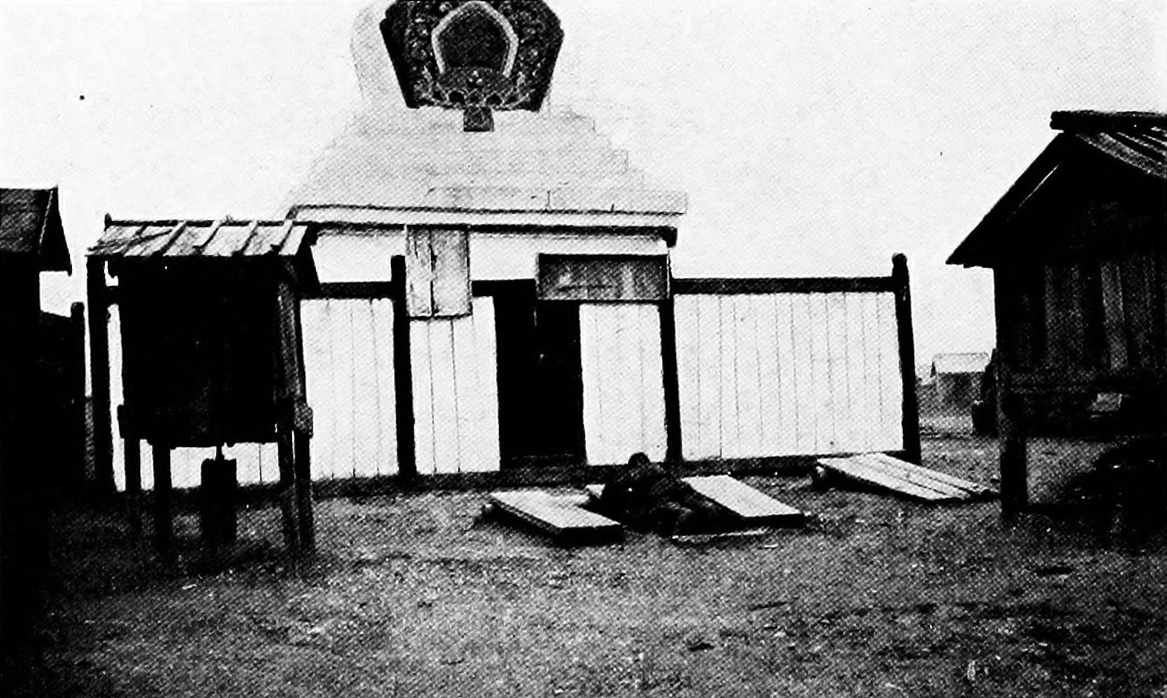Since the second century B.C., Mongolia came under the influence of Buddhism from the South. As a result, the beliefs of Northern Shamanism existed side by the side with Buddhism. This was the start of the third historical stage of Mongolian Shamanism. Henceforth, there was an ideological rivalry between Buddhism and Shamanism; the former aiming to dominate the Central Asian Steppe and the latter striving to perpetuate its authority. The struggle yo put a Buddhist ideal in the Haan’s Palace of the Great Nirun Empire is a clear example of this.
It is clear from the sources that Chunu Haan, placed in a hopeless situation by persecution from his own mother, pretended to accept the installation of an idol in his Palace, but then sent it covertly to the Wey Dynasty. In this way, Chunu Haan remained true to his Shaman beliefs, while other magnates of Great Nirun |including his mother| preferred Buddhism and conspired to make it the dominant state religion. This rivalry between the nobles of Great Nirun, for example between the Haan and his mother, was a major cause of the empire’s collapse in 555.
Although ideological contradiction and conflicts between Shamanism and Buddhism have been continuous, Shamanism held on to primacy along the “Silk Road” and particularly in mountain and steppe areas to the north of the Gobi desert. However, it is evident that under the influence of Buddhism and other religions, Shamanism underwent major changes during the twelfth and thirteenth centuries.
As stated above, during the establishment of the first Mongolian State, Chinggis Haan kept a close relationship with the Shamans and carried out any state and military actions in accordance with their advice. In this respect, he was entirely faithful to the main basis of the shaman conception of Water and earth Spirits and to the power and authority of ancestral spirits too. His warriors were educated to believe in the amulet of Black heaven and the spirit of the Black Symbol.
The Mongolian soldiers, who were instructed in this shaman ideology, burned down the temples and synagogues of other religions without hesitation during their foreign campaigns. An apt example is the general Tomorbuyant, son of Hubilay Haan, whose forces attacked Tibet and burned down every Buddhist Monastery in the country.
It is uncertain whether or not there was a Shaman at the head of the national religion during ancient times, but since Chinggis Haan’s period, Tiv-Tengger was the most important Shaman and the closest one to Chinggis Haan, who elevated him to the rank of State Shaman. Ogoodey Haan also had a trusted Shaman who, according to the Secret History, served as his regent when Ogoodey was ill during war in China.
Moreover, Gilliom de Roubruc revealed that, among the Shamans of Monh Haan, a ‘zayran” was preeminent. By the reign of Hubilay Haan, the influence of Mongolian Shamanism upon the state officials and institutions had begun declining. However, the influence of archaic Shamanism in the northern part of the nomadic civilization of the Great Yuan Empire remained substantial. The main cause of this phenomenon was that Mongolian Shamans had a close relationship with their Siberian colleagues to the north, which created a suitable opportunity for the renovation and rehabilitation of their own influence when the political situation was favorable.
It is almost certain that this kind of relationship dates back much further, but today there is only evidence of intercommunication between Mongolian, Tuvan, Buriad, and Uighur Shamans after the thirteenth century.
The household of the most influential Shaman of the 13th century, “Tiv-Tengger Zayran”, was located in Barguujin Tuhem, to the northeast of Lake Baikal |Baigal|. Moreover, there is a legend that he took a daughter of Chinggis Haan and fled away and, when he was about to be seized, hid her in a cavern and changed himself into a statue. There is also a tradition that Dayan Deerh Zayran was from the Hori Tumed area- on the eastern shore of Lake Hovsgol or Dalay eej.
According to the Mongolian Shaman conception, all things and events have their antithesis. For example, killing animals is balanced by husbandry, war by friendship, cursing against blessing and life against death. Each side of this balance is given equal importance.
In regard to such activities carried out by Mongolian Shamans, Plano Di Carpini wrote his own experience, “The Tatars do not consider it sinful when they kill a man, invade the territory of other nations, steal their riches, commit adultery, scorn or offend others, break God’s commands and so on”. Indeed, that period was one of every kind of rivalry, pitting steel against Burhan |God’s| commandments.
Instead of blind obedience, Mongolian Shamanism encouraged in its believers the values of courage and patience. Thanks to this and the belief in the spirits of the Heavens, waters, land and ancestors, the most courageous and heroic of our ancestors fought tirelessly for the independence and territorial safety of their motherland.

